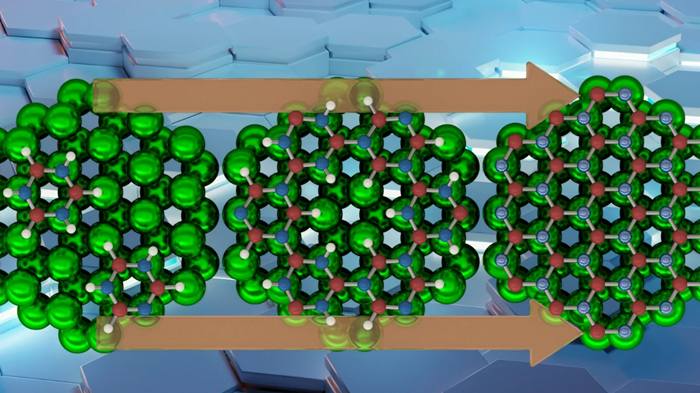According to researchers from the University of Surrey, a breakthrough in understanding the growth process of the 2D material Hexagonal Boron Nitride (hBN) and its nanostructures on metal substrates may open the door to cleaner energy sources, more effective electronics, and environmentally friendly chemical manufacturing. The study has been published in Small.
 New 'nanoporous' hBN 2D material discovered. Image Credit: University of Surrey
New 'nanoporous' hBN 2D material discovered. Image Credit: University of Surrey
The ultra-thin, extremely resilient material known as "white graphene" (hBN), which is only one atom thick, can withstand high temperatures, prevent chemical damage, and block electrical currents. Due to its exceptional adaptability, it can shield sensitive microchips and facilitate the creation of faster, more effective transistors, making it a crucial part of sophisticated electronics.
Scientists have shown that nanoporous hBN, a novel material with structured voids that enable selective absorption, advanced catalysis, and enhanced functionality, can be formed. This greatly expands the material's potential environmental applications, which encompass detecting and filtering pollutants as well as advancing energy systems such as hydrogen storage and electrochemical catalysts for fuel cells.
Our research sheds light on the atomic-scale processes that govern the formation of this remarkable material and its nanostructures. By understanding these mechanisms, we can engineer materials with unprecedented precision, optimizing their properties for various revolutionary technologies.
Dr. Marco Sacchi, Study Lead Author and Associate Professor, School of Chemistry and Chemical Engineering, University of Surrey
Dr. Marco Sacchi is also a Royal Society University Research Fellow in Physical and Computational Chemistry and a Theme Leader in Sustainable Energy and Materials Research.
In collaboration with Austria's Graz University of Technology (TU Graz), the team, led by Dr. Marco Sacchi, with theoretical contributions from Dr. Anthony Payne and Dr. Neubi Xavier, utilized density functional theory and microkinetic modeling to investigate the growth process of hBN from borazine precursors.
They analyzed key molecular processes, including diffusion, decomposition, adsorption, desorption, polymerization, and dehydrogenation. This methodology allowed them to create an atomic-scale model capable of guiding the material's growth at any temperature.
The theoretical simulations' insights closely match the Graz research group's experimental observations, paving the way for the controlled, superior production of hBN with particular designs and functionalities.
Previous studies have neither considered all these intermediates nor such a large parameter space (temperature and particle density). We believe that it will be useful to guide the chemical vapor deposition growth of hBN on other metallic substrates, as well as the synthesis of nanoporous or functionalized structures.
Dr. Anton Tamtögl, Study Lead Researcher, Graz University of Technology (TU Graz)
The UK’s HPC Materials Chemistry Consortium and the Austrian Science Fund supported the study.
Journal Reference:
Sacchi, M., et al. (2024) Unravelling the Epitaxial Growth Mechanism of Hexagonal and Nanoporous Boron Nitride: A First-Principles Microkinetic Model. Small. doi.org/10.1002/smll.202405404